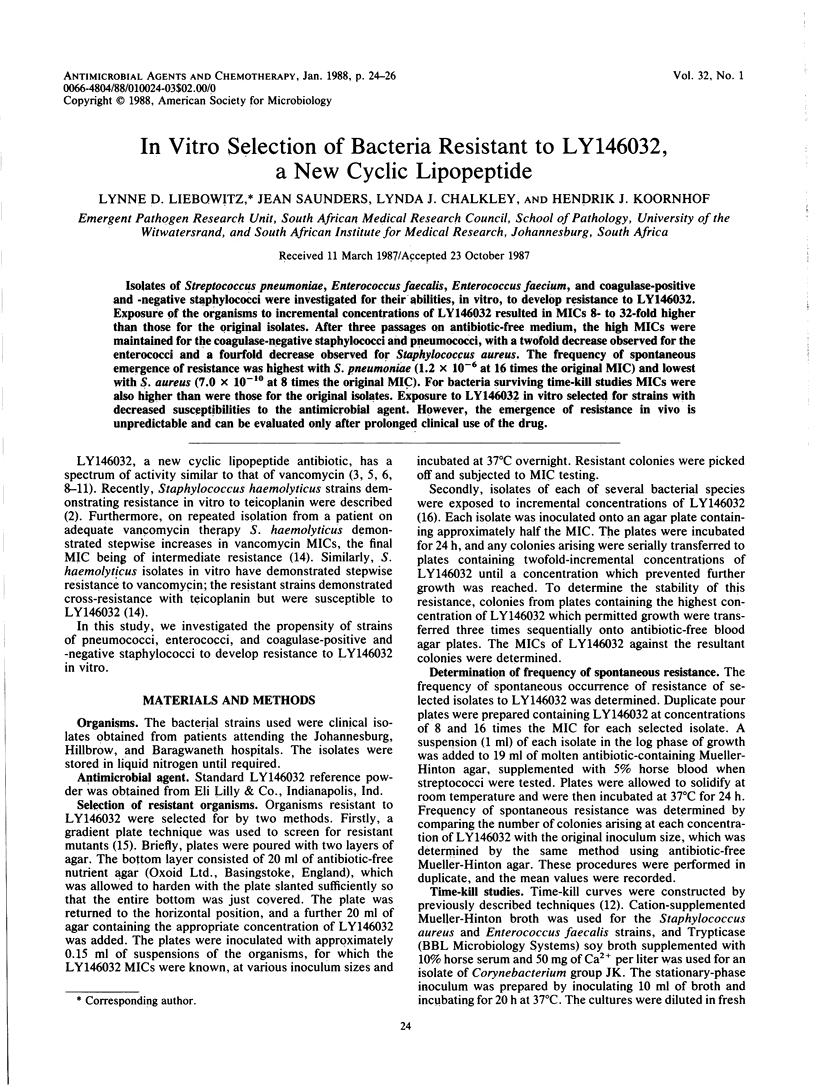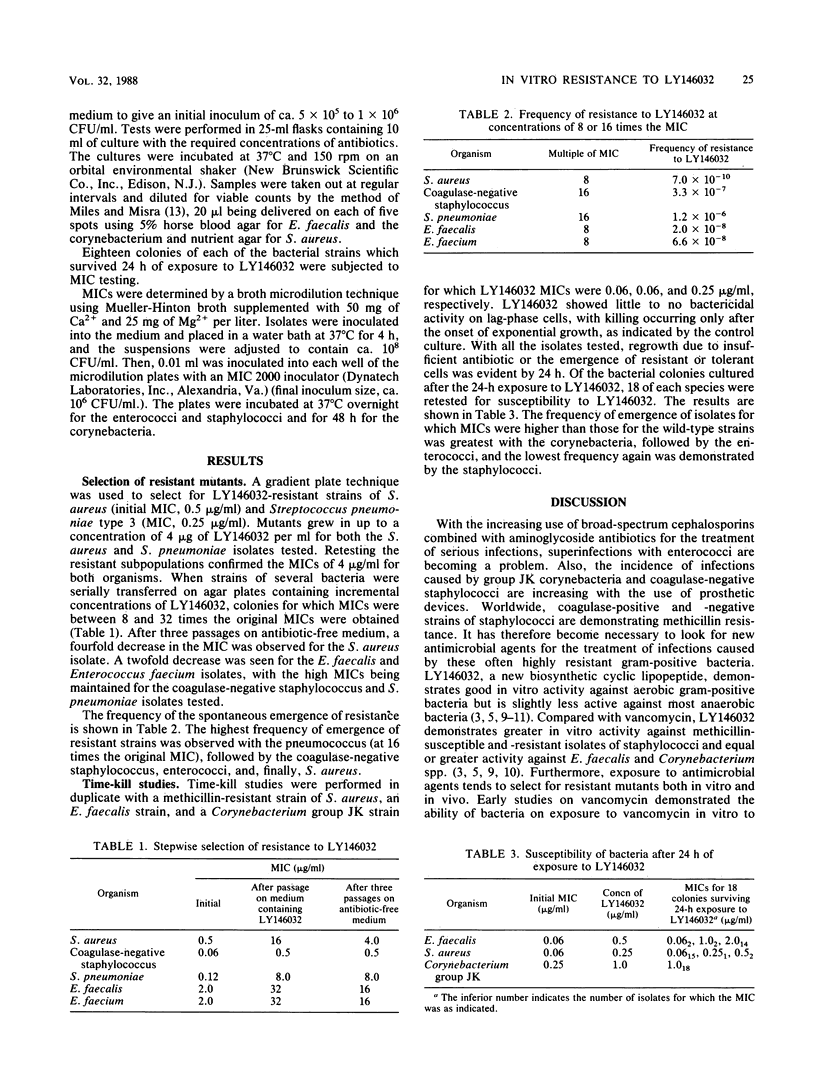Abstract
Isolates of Streptococcus pneumoniae, Enterococcus faecalis, Enterococcus faecium, and coagulase-positive and -negative staphylococci were investigated for their abilities, in vitro, to develop resistance to LY146032. Exposure of the organisms to incremental concentrations of LY146032 resulted in MICs 8- to 32-fold higher than those for the original isolates. After three passages on antibiotic-free medium, the high MICs were maintained for the coagulase-negative staphylococci and pneumococci, with a twofold decrease observed for the enterococci and a fourfold decrease observed for Staphylococcus aureus. The frequency of spontaneous emergence of resistance was highest with S. pneumoniae (1.2 X 10(-6) at 16 times the original MIC) and lowest with S. aureus (7.0 X 10(-10) at 8 times the original MIC). For bacteria For bacteria surviving time-kill studies MICs were also higher than were those for the original isolates. Exposure to LY146032 in vitro selected for strains with decreased susceptibilities to the antimicrobial agent. However, the emergence of resistance in vivo is unpredictable and can be evaluated only after prolonged clinical use of the drug.
Full text
PDF


Selected References
These references are in PubMed. This may not be the complete list of references from this article.
- Appelbaum P. C., Bhamjee A., Scragg J. N., Hallett A. F., Bowen A. J., Cooper R. C. Streptococcus pneumoniae resistant to penicillin and chloramphenicol. Lancet. 1977 Nov 12;2(8046):995–997. doi: 10.1016/s0140-6736(77)92892-6. [DOI] [PubMed] [Google Scholar]
- Arioli V., Pallanza R. Teicoplanin-resistant coagulase-negative staphylococci. Lancet. 1987 Jan 3;1(8523):39–39. doi: 10.1016/s0140-6736(87)90724-0. [DOI] [PubMed] [Google Scholar]
- Ehlert F., Neu H. C. In vitro activity of LY146032 (daptomycin), a new peptolide. Eur J Clin Microbiol. 1987 Feb;6(1):84–90. doi: 10.1007/BF02097208. [DOI] [PubMed] [Google Scholar]
- Eliopoulos G. M., Moellering A. E., Reiszner E., Moellering R. C., Jr In vitro activities of the quinolone antimicrobial agents A-56619 and A-56620. Antimicrob Agents Chemother. 1985 Oct;28(4):514–520. doi: 10.1128/aac.28.4.514. [DOI] [PMC free article] [PubMed] [Google Scholar]
- Eliopoulos G. M., Willey S., Reiszner E., Spitzer P. G., Caputo G., Moellering R. C., Jr In vitro and in vivo activity of LY 146032, a new cyclic lipopeptide antibiotic. Antimicrob Agents Chemother. 1986 Oct;30(4):532–535. doi: 10.1128/aac.30.4.532. [DOI] [PMC free article] [PubMed] [Google Scholar]
- Fass R. J., Helsel V. L. In vitro activity of LY146032 against staphylococci, streptococci, and enterococci. Antimicrob Agents Chemother. 1986 Nov;30(5):781–784. doi: 10.1128/aac.30.5.781. [DOI] [PMC free article] [PubMed] [Google Scholar]
- GERACI J. E., HEILMAN F. R., NICHOLS D. R., WELLMAN E. W., ROSS G. T. Some laboratory and clinical experiences with a new antibiotic, vancomycin. Antibiot Annu. 1956:90–106. [PubMed] [Google Scholar]
- Gunnison J. B., Fraher M. A., Pelcher E. A., Jasetz E. Penicillin-resistant variants of pneumococci. Appl Microbiol. 1968 Feb;16(2):311–314. doi: 10.1128/am.16.2.311-314.1968. [DOI] [PMC free article] [PubMed] [Google Scholar]
- Huovinen P., Kotilainen P. In vitro activity of a new cyclic lipopeptide antibiotic, LY146032, against gram-positive clinical bacteria. Antimicrob Agents Chemother. 1987 Mar;31(3):455–457. doi: 10.1128/aac.31.3.455. [DOI] [PMC free article] [PubMed] [Google Scholar]
- Jones R. N., Barry A. L. Antimicrobial activity and spectrum of LY146032, a lipopeptide antibiotic, including susceptibility testing recommendations. Antimicrob Agents Chemother. 1987 Apr;31(4):625–629. doi: 10.1128/aac.31.4.625. [DOI] [PMC free article] [PubMed] [Google Scholar]
- Knapp C. C., Washington J. A., 2nd Antistaphylococcal activity of a cyclic peptide, LY146032, and vancomycin. Antimicrob Agents Chemother. 1986 Dec;30(6):938–939. doi: 10.1128/aac.30.6.938. [DOI] [PMC free article] [PubMed] [Google Scholar]
- Schwalbe R. S., Stapleton J. T., Gilligan P. H. Emergence of vancomycin resistance in coagulase-negative staphylococci. N Engl J Med. 1987 Apr 9;316(15):927–931. doi: 10.1056/NEJM198704093161507. [DOI] [PubMed] [Google Scholar]
- Tenney J. H., Maack R. W., Chippendale G. R. Rapid selection of organisms with increasing resistance on subinhibitory concentrations of norfloxacin in agar. Antimicrob Agents Chemother. 1983 Jan;23(1):188–189. doi: 10.1128/aac.23.1.188. [DOI] [PMC free article] [PubMed] [Google Scholar]


